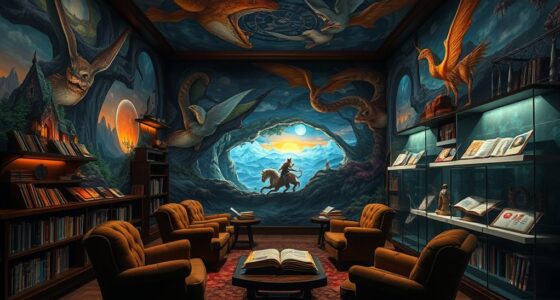Immersive art is a multi-sensory experience that actively involves you in environments filled with light, sound, touch, and smell. Instead of just observing, you explore and interact with installations designed to transport you to new worlds. These experiences evoke emotions and curiosity, making you feel like part of the artwork itself. As technology enhances these environments, you’ll discover how immersive art creates powerful, lasting impressions—and there’s much more to explore just beyond what you see.
Key Takeaways
- Immersive art uses interactive environments to engage multiple senses, transporting viewers into other worlds.
- It encourages active participation, allowing viewers to explore and influence the art experience.
- Multi-sensory elements like sight, sound, touch, and smell evoke emotions and deepen emotional connections.
- Technology-driven features, such as digital projections and sensory devices, enhance the immersive experience.
- The goal is to blur the line between viewer and artwork, creating memorable, visceral interactions.

Have you ever stepped into an art installation and felt completely transported to another world? That’s the magic of immersive art, where you become part of the experience rather than just an observer. At its core, immersive art uses interactive installations designed to engage multiple senses simultaneously, creating a captivating environment that pulls you in. These installations are carefully crafted to stimulate your senses—sight, sound, touch, and sometimes even smell—so that you don’t just see the art, you feel it. This sensory stimulation transforms a simple viewing into a full-bodied experience, making you feel like you’re stepping inside a living, breathing artwork.
When you encounter an immersive piece, you’re encouraged to explore and interact. Unlike traditional art that’s displayed behind glass or on a wall, interactive installations invite your participation. You might walk through a shimmering forest of hanging lights, or manipulate digital projections that respond to your movements. Every interaction reveal new layers of meaning, heightening your engagement. This active participation makes the experience deeply personal; no two visits are exactly alike because your actions shape what you see and feel. It’s this dynamic quality that sets immersive art apart from more conventional forms, allowing you to become a part of the narrative or the visual spectacle itself.
Sensory stimulation is at the heart of these environments. They’re designed to enthrall your senses in ways that evoke emotion, curiosity, or even introspection. For example, a room might pulse with rhythmic sounds synchronized to colorful light displays, creating an almost hypnotic effect. Touch-sensitive surfaces might respond to your touch with vibrations or temperature changes, making you aware of your physical presence within the space. Sometimes, subtle smells are incorporated to evoke specific memories or moods, adding another layer of immersion. This multi-sensory approach doesn’t just make the art more engaging; it also heightens your emotional response, making the experience memorable and impactful. Additionally, immersive art often incorporates technology-driven elements that enhance the overall experience and further blur the lines between art and audience.
Ultimately, immersive art blurs the line between viewer and artwork. It invites you to step inside a carefully curated universe where your senses are constantly stimulated and your actions influence what unfolds around you. Whether it’s through interactive installations, evocative soundscapes, or tactile elements, this art form transforms passive observation into active participation. As a result, you leave not just with visual impressions but with a richer, more visceral connection to the art itself. That’s the power of immersive art—creating multi-sensory experiences that resonate long after you’ve stepped out of the installation.
Frequently Asked Questions
How Does Immersive Art Influence Emotional Responses?
Immersive art influences your emotional responses by fostering deep emotional engagement through intense sensory stimulation. As you navigate the multi-sensory environment, your feelings are heightened, making experiences more memorable and impactful. The combination of visuals, sounds, and tactile elements creates a compelling connection, allowing you to feel more connected and emotionally moved. This powerful sensory stimulation enhances your overall emotional experience, leaving a lasting impression on your mind and heart.
What Technologies Are Commonly Used in Creating Immersive Experiences?
Over 70% of immersive art experiences incorporate cutting-edge technologies like virtual reality and projection mapping. These tools transport you into new worlds by creating realistic, multi-sensory environments. Virtual reality immerses you fully, while projection mapping transforms surfaces into dynamic displays. Together, they enable artists to craft engaging, interactive experiences that captivate your senses and evoke emotional responses, making immersive art both innovative and deeply personal.
Can Immersive Art Be Accessible for People With Disabilities?
Yes, immersive art can be accessible for people with disabilities. You can use adaptive technologies, like audio descriptions, tactile interfaces, and visual aids, to overcome accessibility barriers. Artists and venues are increasingly designing experiences that consider diverse needs, ensuring everyone can enjoy multi-sensory engagement. By integrating these tools, you’ll find immersive art becomes more inclusive, allowing you to fully participate regardless of your abilities.
How Do Artists Design Multi-Sensory Environments Effectively?
Designing multi-sensory environments is like crafting a symphony, where each element harmonizes seamlessly. You should focus on spatial design to guide visitors naturally and ensure sensory integration by thoughtfully combining visuals, sounds, textures, and scents. Use varied stimuli to evoke emotions and create immersion. Test your setup frequently, adapt to feedback, and aim for a balanced experience that engages all senses without overwhelming, making your art truly mesmerizing.
What Are the Future Trends in Immersive Art Development?
Future trends in immersive art development will likely hinge on technological innovations that deepen audience engagement. You’ll see more interactive digital projections, virtual and augmented reality experiences, and AI-driven environments that respond to your movements and emotions. These advancements will make immersive art more personalized, dynamic, and accessible, transforming how you experience multi-sensory environments and connecting you more deeply with the artwork.
Conclusion
As you step back from the world of immersive art, you realize you’ve entered a vibrant universe where senses intertwine like a symphony of colors and sounds. It’s a portal that pulls you into a dreamscape, blurring the lines between reality and imagination. In this kaleidoscope of sensations, you become both observer and participant, forever changed by the multi-sensory journey. Immersive art invites you to lose yourself to find a deeper sense of wonder within.









